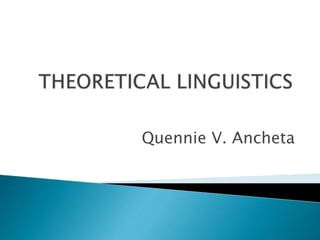
The Evolution of Linguistic Theories
- 2. -To understand current ideas, we need to know where they came from.
- 3. Can’t we just observe language and describe it without bothering with difficult things like theories? The human mind always operates with some notion of the way the universe works. The human mind finds it easier to understand things if we break it down into smaller pieces
- 4. Language exists in people’s heads Language is ‘rules’ that we know: competence
- 5. –You can observe what goes in and out of the box, but you can’t observe what goes on inside which changes the input to the output –By studying the input and output we can imagine what must be going on inside –Imagined processes = theory
- 6. American structuralism (C1900 – 1960) Transformational Grammar (1957 – 1964) Standard Generative Theory (1964 – 1980) Government and Binding Theory Generalised Phrase Structure Grammar Lexical Functional Grammar (1980 – present) Minimalist Programme Optimality Theory (1993 – present)
- 7. We can only study what we can observe We can observe sound – So we can study phonetics If we assume that phonology is based on phonetics, we can study phonology too If we assume that morphology is based on phonology, we can study morphology If we assume that syntax is based on morphology, we can study syntax We can’t study semantics – leave that to philosophers
- 8. –The unit of phonology (phoneme) is a collection of phones (observable) and distinguished in terms of the distribution of phones –The unit of morphology (morpheme) is a combination of phonemes and distinguished in terms of distribution –The unit of syntax (word) is a combination of morphemes, distinguished by distribution
- 9. Rationalist approach –The mind exists and can be studied –Some knowledge comes from the mind itself Discovery procedures are foolish and limiting –You get your data from wherever you can find it (not limited to observable data – i.e. Intuition also acceptable)
- 10. …is that branch of linguistics that is most concerned with developing models of linguistic knowledge.
- 12. …is the study of the articulation, the perception and the physical aspects of speech sounds.
- 13. Articulatory phonetics Auditory phonetics Acoustic phonetics
- 14. Articulatory phonetics analyses the movements of speech organs by which certain sounds are produced. Auditory phonetics is concerned with the perception of speech sounds through the ear (hence auditory), and begins with the anatomy of this organ in a similar way to articulatory phonetics. Acoustic phonetics studies the physical aspects of speech sounds.
- 15. …is the branch of theoretical linguistics concerned with speech sounds at a higher level than phonetics, i.e their structure and organisation in human languages.
- 16. …is the study of word structure.
- 17. “A person who knows a language has mastered a system of rules that assigns sound and meaning in a definite class of possible sentences.” - Noam Chomsky
- 18. …is the study of language structure and word order.
- 19. Speakers of a language recognize the grammatical sentences of their language and know how the words in a sentence must be ordered and grouped to convey a certain meaning. All speakers are capable of producing and understanding an unlimited number of new sentences that have never before been spoken or heard.
- 20. They also recognize ambiguities, know when different sentences mean the same thing, and correctly interpret the grammatical relations in a sentence, such as subject and direct object. This kind of knowledge comes from their knowledge of the rules of syntax.
- 21. The notion of structure stays –Words group into phrases –Phrases group into sentences New type of rule for producing structure –S NP VP A set of such rules makes a Phrase Structure Grammar –Grammar is a set of rules that are part of the mind
- 22. But phrase structure rules are not enough to describe human languages –Discontinuous constituents [A man with blue eyes] walked into a shop [A man] walked into a shop [with blue eyes] To describe this phenomena we need transformations –Rules which alter structures to form other structures (e.g. By moving things about)
- 23. What does the grammar manipulate? – From structuralism we have always assumed that words are the basis of syntax – But transformational analyses started to discover that units smaller than words undergo syntactic processes: He is always sad He always phones his mother – Some have suggested that this leads to a theory where syntax always manipulates items smaller than the word and that words are constructed by syntax
- 24. …is the study of intensive meaning in words and sentences.
- 25. www.wikipedia.com Barker, Chris: Oxford Studies in Theoretical Linguistics; Oxford University Press;2007. Chomsky, Noam Current Issues in Linguistic Theory. The Hague: Mouton.1964 Fromkin, Victoria: Introduction to Linguistics: Cengage Leraning Asia, 2010. Lyons, John: Introduction to Theoretical Linguistics; Cambridge University Press; Melbourne, Australia; Digital Printing 2001.
